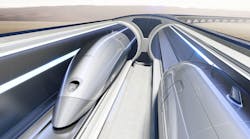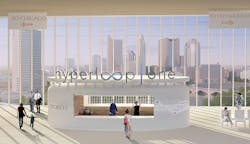Ohio, home to some of the fastest roller coasters in the world, may soon have a high-speed transport system that will actually take people somewhere other than back where they started. Both Virgin Hyperloop One and Hyperloop Transportation Technologies have competing projects now racing to get feasibility and environmental impact studies underway.
Both projects seek to connect America’s Midwestern manufacturing metropolises together in a way that could completely transform the nation’s supply chain. Hyperloop One’s route, proposed by the Mid-Ohio Regional Planning Commission (MORPC) and one of ten winning submissions of the company’s Global Challenge, would travel from Pittsburgh through Columbus to Chicago in 47 minutes. It would create a Great Lakes Megaregion and connect 20% of the population. Feasibility and environmental impact studies are expected to total $2.5 million, with the former taking nine months to complete and the latter building off those findings and taking a year.
Here’s the route.
The HTT project would whisk passengers and freight from Cleveland to Chicago in about 28 minutes, cutting the trip down from five to six hours.
Neither company has demonstrated they can get a train to reach these speeds using magnetic levitation in a near-vacuum environment. Elon Musk wrote a lengthy dissertation on how the technology could theoretically work, but the techno-savant has his hands full with making electric cars and then shooting them at Mars. So this will have to be completed by mere mortals. Or another magnetic billionaire with galactic ambitions.
After some internal restructuring, Sir Richard Branson became chairman of Virgin Hyperloop One this year. The startup has several international agreements to develop systems, from India to England. At the DevLoop test track in Nevada, engineers are figuring out how to increase speeds from 240 mph to 670 mph. The goal is to have a working hyperloop by 2021.
Even though we’re based in Cleveland and would love to cut our travel time to the International Manufacturing Technology Show, the Hyperloop One project, the “Midwest Connect” makes more sense.
First, let’s lay out why HTT believes Cleveland and Chicago would make ideal hubs.
The logic for the project sounds like it came straight from the cities’ tourism boards after binging “Mad Men”:
“Where do you go to make dreams? To build them—with metal and glass and your own two hands?” the video’s narrator asks in his best Don Draper delivery. “You go to cities unafraid of work, and people known for making things.”
HTT believes Cleveland and Chicago fit this description, and at one time they certainly did, no question about it.
"We came here because places like Cleveland, Chicago and Pittsburgh have the manufacturing, the raw materials and the talented, hard-working people in order to make it happen," says Andrea La Mendola Chief Global Operations Officer of Hyperloop Transportation Technologies. "We can source everything from this area. This is a place where you make big things."
Even as they move towards service-oriented economies, both cities do exude a blue-collar grit. They appear to have the infrastructure, the waterways and the manufacturing base to tackle a project of this nature. The $600,000 feasibility study funded by the Northeast Ohio Areawide Coordinating Agency (NOACA), is expected to begin in March and last up to one year. By then HTT hopes this argument proves cogent.
But for this specific project to be the inaugural hyperloop, the one that would inspire dozens of others around the globe, don’t you need more than strong manufacturing bones?
The Midwest has evolved since the heyday of steel, and while manufacturing is still vital to both, is it enough to justify such a huge project? According to World Business Chicago, no single industry employs more than 12% of the 4-million strong workforce, making it the most diversified economy in America.
Cleveland projects a lot better on the global stage than it did following the Great Recession, but in 2016 was named the country’s “most distressed city” by the Economic Innovation Group. The study relied on stats from 2010 to 2013, but if you’re goal is to make dreams, don’t start building on a nightmarish foundation.
Still home to manufacturing giants Lincoln Electric and Parker Hannifin, potentially integral partners for the project, the city does have some things going for it.
But enough to justify a 300-mile transportation system?
Interstate 90 is a straight shot from Cleveland to the Windy City; an Amtrak ticket costs $46. Each takes approximately five to six hours. And the SS Edmund Fitzgerald notwithstanding, cargo is successfully hauled via the Great Lakes all the time.
Musk projected in California one mile of track would cost $17 million. That equals $5.2 billion, and that number could be much higher.
For this type of expenditure, the solution should solve much more than knocking four hours off your material handling time and whatever indirect carbon emissions could be prevented.
That’s why cutting through the heart of the Buckeye State appears more beneficial.
There is no direct rail or highway route that links Pittsburgh, Columbus, and Chicago, though 5.9 million tons of freight moved between the three in 2015. By 2040, the interstate supply chain will be even more taxed, with 9 million tons— worth nearly $30 billion— hauled between the three.
For Columbus in particular, the hyperloop would be a welcome additional asset to leverage, along with the Rickenbacker International Cargo Airport.
"Over the last five years, the Rickenbacker airport has seen an impressive increase of enplaned and deplaned cargo, and it is only projected to increase in the years to come," says Dina López, a freight specialist at MORPC.
Online shopping looks to push that those projections even further.
"We also considered eCommerce, and the strain on the existing multimodal transportation system to keep up with the increasing consumer demand for one to two-day deliveries," López says. Integrating hyperloop service into the supply chain could help keep up with consumer shifts towards eCommerce."
And although López says MORPC is "supportive of Cleveland's pursuit," maybe its in the same way Ohio State Buckeyes fans are supportive that the Cleveland Browns may someday win a game. Because when to it comes to which area is more vital to the overall strength of the nation getting its goods shipped and delivered faster, it seems there's no contest.
In September 2017, Cleveland-Hopkins handled 6,884 tons of cargo. In the same month, Rickenbacker nearly doubled that with 11,920 tons.
Speeding up travel time in this hub would also have a direct impact on the global food supply.
"In Columbus we have [Rickenbacker] that exports food products directly," says William Murdock, executive director of MORPC. "If you can get perishables to Columbus in 20 minutes, you’re exporting next day from the fields of Indiana to the Middle East or Japan.”
The state's capital will also receive up to $40 million in federal funding to develop a high-tech 21st century infrastructure for winning the Department of Transportation’s Smart City Challenge. This is in addition to $90 million raised from private partnerships. Juxtapose that against Cleveland, where my commute to our downtown office involves puttering bumper-to-bumper around a sharp bend in I-90 lovingly called Dead Man’s Curve at 5 mph. Not smart.
No one knows if either of these, or any hyperloop, will ever get off the ground. what is certain is that Columbus has a lot going for it in terms of the supply chain, and is quadrupling Cleveland's investment on studies to vet that this is a worthwhile endeavor. Nothing would thrill me more than if the engineers and surveyors do their due diligence, discover building a Cleveland hyperloop is brilliant idea. But as someone who has covered both the technology and the city extensively, Cleveland just doesn't make sense. Columbus totally does, even winning an international contest verifying such. Plus they have the money and they need it.
The good thing for Cleveland is that even if it loses this race, it would only be a two-hour trip to the Columbus hyperloop hub, cutting the travel time to Chicago by half. And nothing would stop a future hub from being built to connect the two.
Now that's what being a smart city really is about.








